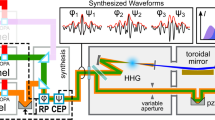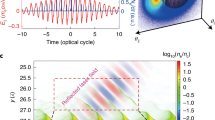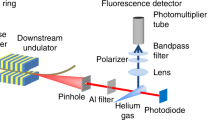Abstract
Today, light fields of controlled and measured waveform can be used to guide electron motion in atoms and molecules with attosecond precision. Here, we demonstrate attosecond control of collective electron motion in plasmas driven by extreme intensity (≈1018 W cm−2) light fields. Controlled few-cycle near-infrared waves are tightly focused at the interface between vacuum and a solid-density plasma, where they launch and guide subcycle motion of electrons from the plasma with characteristic energies in the multi-kiloelectronvolt range—two orders of magnitude more than has been achieved so far in atoms and molecules. The basic spectroscopy of the coherent extreme ultraviolet radiation emerging from the light–plasma interaction allows us to probe this collective motion of charge with sub-200 as resolution. This is an important step towards attosecond control of charge dynamics in laser-driven plasma experiments.
This is a preview of subscription content, access via your institution
Access options
Subscribe to this journal
Receive 12 print issues and online access
$209.00 per year
only $17.42 per issue
Buy this article
- Purchase on Springer Link
- Instant access to full article PDF
Prices may be subject to local taxes which are calculated during checkout




Similar content being viewed by others
References
Esarey, E., Schroeder, C. B. & Leemans, W. P. Physics of laser-driven plasma-based electron accelerators. Rev. Mod. Phys. 81, 1229–1285 (2009).
Malka, V. et al. Principles and applications of compact laser-plasma accelerators. Nature Phys. 4, 447–453 (2008).
Baltuska, A. et al. Attosecond control of electronic processes by intense light fields. Nature 421, 611–615 (2003).
Uiberacker, M. et al. Attosecond real-time observation of electron tunnelling in atoms. Nature 446, 627–632 (2007).
Eckle, P. et al. Attosecond ionization and tunneling delay time measurements in helium. Science 322, 1525–1529 (2008).
Goulielmakis, E. et al. Real-time observation of valence electron motion. Nature 466, 739–743 (2010).
Kling, M. F. et al. Control of electron localization in molecular dissociation. Science 312, 246–248 (2006).
Sansone, G. et al. Electron localization following attosecond molecular photoionization. Nature 465, 763–766 (2010).
Cavalieri, A. L. et al. Attosecond spectroscopy in condensed matter. Nature 449, 1029–1032 (2007).
Schultze, M. et al. Delay in photoemission. Science 328, 1658–1662 (2010).
Ivanov, M. & Krausz, F. Attosecond physics. Rev. Mod. Phys. 81, 163–234 (2009).
Heissler, P. et al. Toward single attosecond pulses using harmonic emission from solid-density plasmas. Appl. Phys. B 101, 511–521 (2010).
Rolland, C. & Corkum, P. B. Generation of 130-fsec midinfrared pulses. J. Opt. Soc. Am. B 3, 1625–1629 (1986).
Kapteyn, H. C., Murnane, M. M., Szoke, A. & Falcone, R. W. Prepulse energy suppression for high-energy ultrashort pulses using self-induced plasma shuttering. Opt. Lett. 16, 490–492 (1991).
Doumy, G. et al. Complete characterization of a plasma mirror for the production of high-contrast ultraintense laser pulses. Phys. Rev. E 69, 026402 (2004).
Dromey, B., Kar, S., Zepf, M. & Foster, P. The plasma mirror—A subpicosecond optical switch for ultrahigh power lasers. Rev. Sci. Instrum. 75, 645–649 (2004).
Thaury, C. et al. Plasma mirrors for ultrahigh-intensity optics. Nature Phys. 3, 424–429 (2007).
Brunel, F. Not-so-resonant, resonant absorption. Phys. Rev. Lett. 59, 52–55 (1987).
Bonnaud, G., Gibbon, P., Kindel, J. & Williams, E. Laser interaction with a sharp-edged overdense plasma. Laser Part. Beams 9, 339–354 (1991).
Thaury, C. & Quéré, F. High-order harmonic and attosecond pulse generation on plasma mirrors: Basic mechanisms. J. Phys. B 43, 21300 (2010).
Kruer, W. L. The Physics of Laser Plasma Interaction (Westview Press, 2003).
Hinkel-Lipsker, D. E., Fried, B. D. & Morales, G. J. Analytic expressions for mode conversion in a plasma with a linear density profile. Phys. Fluids B 4, 559–575 (1992).
Sheng, Z-M., Mima, K., Zhang, J. & Sanuki, H. Emission of electromagnetic pulses from laser wakefields through linear mode conversion. Phys. Rev. Lett. 94, 095003 (2005).
Quéré, F. et al. Coherent wake emission of high-order harmonics from overdense plasmas. Phys. Rev. Lett. 96, 125004 (2006).
Nomura, Y. et al. Attosecond phase locking of harmonics emitted from laser-produced plasmas. Nature Phys. 5, 124–128 (2009).
Borot, A. et al. High-harmonic generation from plasma mirrors at kilohertz repetition rate. Opt. Lett. 36, 1461–1463 (2011).
Quéré, F. et al. Phase properties of laser high-order harmonics generated on plasma mirrors. Phys. Rev. Lett. 100, 095004 (2008).
Thaury, C. et al. Coherent dynamics of plasma mirrors. Nature Phys. 4, 631–634 (2008).
Amidror, I The Theory of the Moiré Phenomenon 2nd edn, Vol. I (Springer, 2009).
Acknowledgements
The authors would like to thank M. Ivanov for fruitful discussions, E. Lefebvre for providing the PIC code CALDER and R. Nuter for modifying this code to include the CE phase parameter. The 2D PIC calculations were performed using the computing resources of the ‘Grand Equipement National de Calcul Intensif’ (GENCI), under project number 2011-056057, and those of the ‘Centre de Calcul Recherche et Technologie’ (CCRT). Financial support was received from the Agence Nationale pour la Recherche through programme Chaire d’Excellence 2004 and ANR-09-JC-JC-0063 (UBICUIL). A.B. acknowledges financial support from the réseaux thématiques de recherche avancée—Triangle de la Physique and F.Q. from the European Research Council (ERC grant agreement no 240013).
Author information
Authors and Affiliations
Contributions
The experimental set-up was designed by A.B. and R.L-M., the driving laser system was developed by A.J., X.C. and R.L-M., the experiments were carried out by A.B. and A.M., the theoretical work was done by A.M. and F.Q. All authors participated in the elaboration of the research project.
Corresponding author
Ethics declarations
Competing interests
The authors declare no competing financial interests.
Supplementary information
Supplementary Information
Supplementary Information (PDF 332 kb)
Rights and permissions
About this article
Cite this article
Borot, A., Malvache, A., Chen, X. et al. Attosecond control of collective electron motion in plasmas. Nature Phys 8, 416–421 (2012). https://doi.org/10.1038/nphys2269
Received:
Accepted:
Published:
Issue Date:
DOI: https://doi.org/10.1038/nphys2269
This article is cited by
-
Ionization of hydrogen atom driven by ultrashort intense laser pulses: study in momentum space of phase-dependent effects
Indian Journal of Physics (2024)
-
High-harmonic generation from a flat liquid-sheet plasma mirror
Nature Communications (2023)
-
Enhanced coherent transition radiation from midinfrared-laser-driven microplasmas
Scientific Reports (2022)
-
Direct mapping of attosecond electron dynamics
Nature Photonics (2021)
-
Sub-cycle dynamics in relativistic nanoplasma acceleration
Scientific Reports (2019)



